Hyundai Tucson 2020 Owner's Manual - RHD (UK, Australia)
Manufacturer: HYUNDAI, Model Year: 2020, Model line: Tucson, Model: Hyundai Tucson 2020Pages: 637, PDF Size: 64.45 MB
Page 381 of 637

5-64
Driving your vehicle
DBC operation
The DBC may not deactivate on
steep inclines even though the
brake or accelerator pedal is
depressed.
Do not turn on the DBC when
driving with shift lever in 3
rdgear
(and above) for vehicles with
manual transmission. The
engine may stop if the DBC sys-
tem is activated.
The DBC does not operate when:
- The shift lever is in P (Park).
- The ESC is activated.
NOTICE
Standby
Press the DBC button when vehicle speed is under
40km/h. The DBC system will turn ON and enter the
standby mode.
The system does not turn ON if vehicle speed is over
40km/h.
In the standby mode, if vehicle speed is under 35km/h
whilst driving down a steep hill, the DBC will activate
automatically.
In the activated mode, the DBC will temporarily deacti-
vate under the following conditions:
The brake pedal or accelerator pedal is depressed.
If the above conditions are gone, the DBC will automat-
ically activate again.
The DBC will turn OFF under the following conditions:
Activated
Temporarily
deactivated
OFF Mode Indicator light Description
blinks
illuminated
not
illuminated
illuminated
If the DBC red indicator light
illuminates, the system may
have overheated or have mal-
functioned. When the warning
light illuminates even though
the DBC system has cooled off,
we recommend that the vehicle
be checked by an authorised
HYUNDAI dealer as soon as
possible.
WARNING
Page 382 of 637
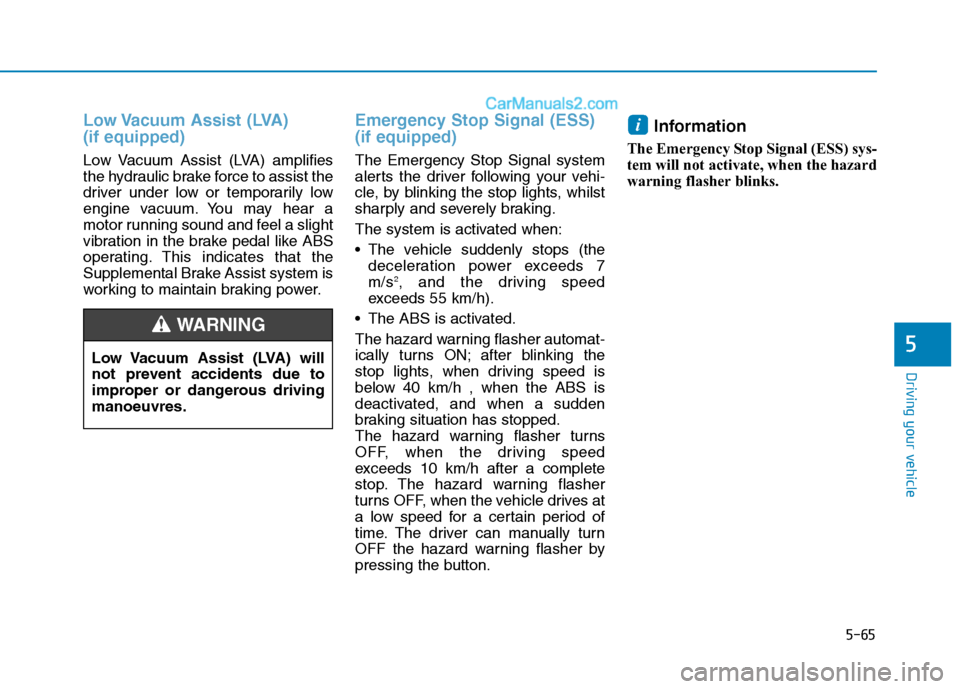
5-65
Driving your vehicle
5
Low Vacuum Assist (LVA)
(if equipped)
Low Vacuum Assist (LVA) amplifies
the hydraulic brake force to assist the
driver under low or temporarily low
engine vacuum. You may hear a
motor running sound and feel a slight
vibration in the brake pedal like ABS
operating. This indicates that the
Supplemental Brake Assist system is
working to maintain braking power.
Emergency Stop Signal (ESS)
(if equipped)
The Emergency Stop Signal system
alerts the driver following your vehi-
cle, by blinking the stop lights, whilst
sharply and severely braking.
The system is activated when:
The vehicle suddenly stops (the
deceleration power exceeds 7
m/s
2, and the driving speed
exceeds 55 km/h).
The ABS is activated.
The hazard warning flasher automat-
ically turns ON; after blinking the
stop lights, when driving speed is
below 40 km/h , when the ABS is
deactivated, and when a sudden
braking situation has stopped.
The hazard warning flasher turns
OFF, when the driving speed
exceeds 10 km/h after a complete
stop. The hazard warning flasher
turns OFF, when the vehicle drives at
a low speed for a certain period of
time. The driver can manually turn
OFF the hazard warning flasher by
pressing the button.
Information
The Emergency Stop Signal (ESS) sys-
tem will not activate, when the hazard
warning flasher blinks.
i
Low Vacuum Assist (LVA) will
not prevent accidents due to
improper or dangerous driving
manoeuvres.
WARNING
Page 383 of 637
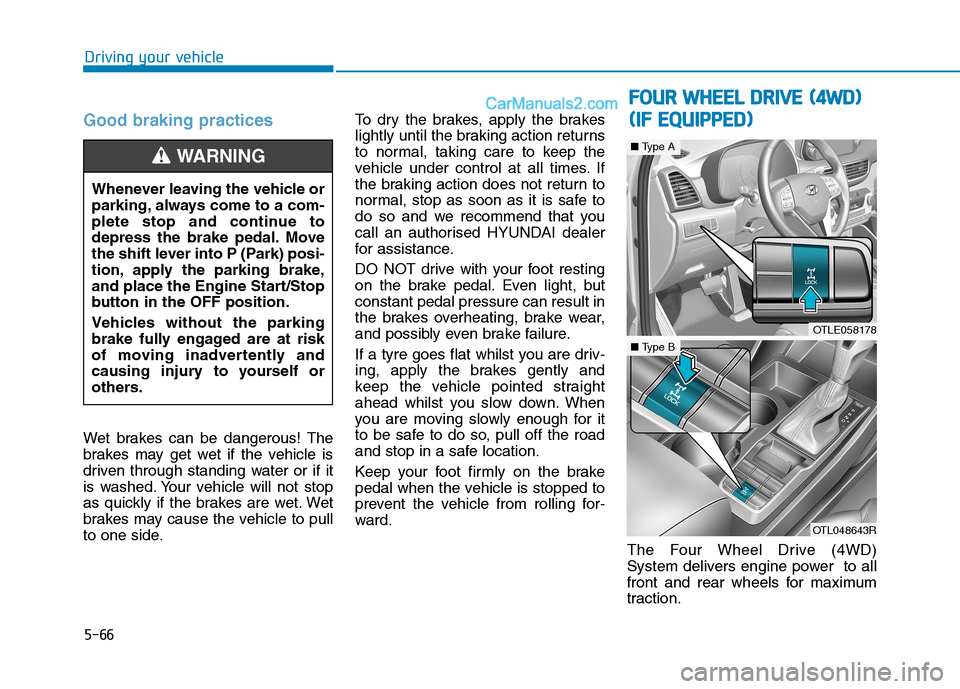
5-66
Driving your vehicle
Good braking practices
Wet brakes can be dangerous! The
brakes may get wet if the vehicle is
driven through standing water or if it
is washed. Your vehicle will not stop
as quickly if the brakes are wet. Wet
brakes may cause the vehicle to pull
to one side.To dry the brakes, apply the brakes
lightly until the braking action returns
to normal, taking care to keep the
vehicle under control at all times. If
the braking action does not return to
normal, stop as soon as it is safe to
do so and we recommend that you
call an authorised HYUNDAI dealer
for assistance.
DO NOT drive with your foot resting
on the brake pedal. Even light, but
constant pedal pressure can result in
the brakes overheating, brake wear,
and possibly even brake failure.
If a tyre goes flat whilst you are driv-
ing, apply the brakes gently and
keep the vehicle pointed straight
ahead whilst you slow down. When
you are moving slowly enough for it
to be safe to do so, pull off the road
and stop in a safe location.
Keep your foot firmly on the brake
pedal when the vehicle is stopped to
prevent the vehicle from rolling for-
ward.
The Four Wheel Drive (4WD)
System delivers engine power to all
front and rear wheels for maximum
traction. Whenever leaving the vehicle or
parking, always come to a com-
plete stop and continue to
depress the brake pedal. Move
the shift lever into P (Park) posi-
tion, apply the parking brake,
and place the Engine Start/Stop
button in the OFF position.
Vehicles without the parking
brake fully engaged are at risk
of moving inadvertently and
causing injury to yourself or
others.
WARNING
OTLE058178
■Type A
OTL048643R
■Type B
F
FO
OU
UR
R
W
WH
HE
EE
EL
L
D
DR
RI
IV
VE
E
(
(4
4W
WD
D)
)
( (I
IF
F
E
EQ
QU
UI
IP
PP
PE
ED
D)
)
Page 384 of 637
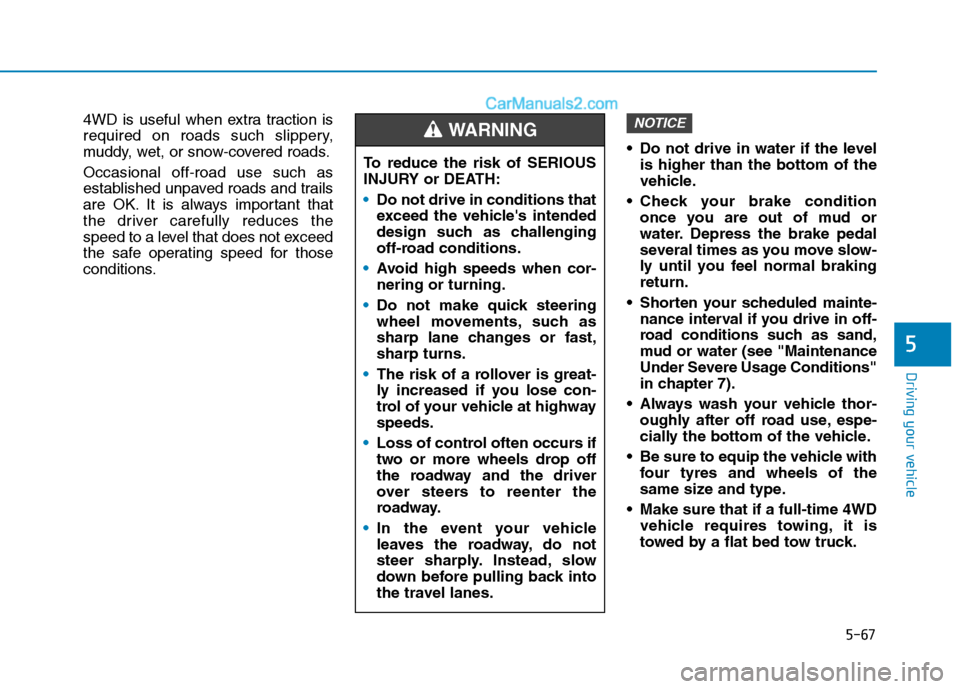
5-67
Driving your vehicle
5
4WD is useful when extra traction is
required on roads such slippery,
muddy, wet, or snow-covered roads.
Occasional off-road use such as
established unpaved roads and trails
are OK. It is always important that
the driver carefully reduces the
speed to a level that does not exceed
the safe operating speed for those
conditions. Do not drive in water if the level
is higher than the bottom of the
vehicle.
Check your brake condition
once you are out of mud or
water. Depress the brake pedal
several times as you move slow-
ly until you feel normal braking
return.
Shorten your scheduled mainte-
nance interval if you drive in off-
road conditions such as sand,
mud or water (see "Maintenance
Under Severe Usage Conditions"
in chapter 7).
Always wash your vehicle thor-
oughly after off road use, espe-
cially the bottom of the vehicle.
Be sure to equip the vehicle with
four tyres and wheels of the
same size and type.
Make sure that if a full-time 4WD
vehicle requires towing, it is
towed by a flat bed tow truck.NOTICE
To reduce the risk of SERIOUS
INJURY or DEATH:
Do not drive in conditions that
exceed the vehicle's intended
design such as challenging
off-road conditions.
Avoid high speeds when cor-
nering or turning.
Do not make quick steering
wheel movements, such as
sharp lane changes or fast,
sharp turns.
The risk of a rollover is great-
ly increased if you lose con-
trol of your vehicle at highway
speeds.
Loss of control often occurs if
two or more wheels drop off
the roadway and the driver
over steers to reenter the
roadway.
In the event your vehicle
leaves the roadway, do not
steer sharply. Instead, slow
down before pulling back into
the travel lanes.
WARNING
Page 385 of 637
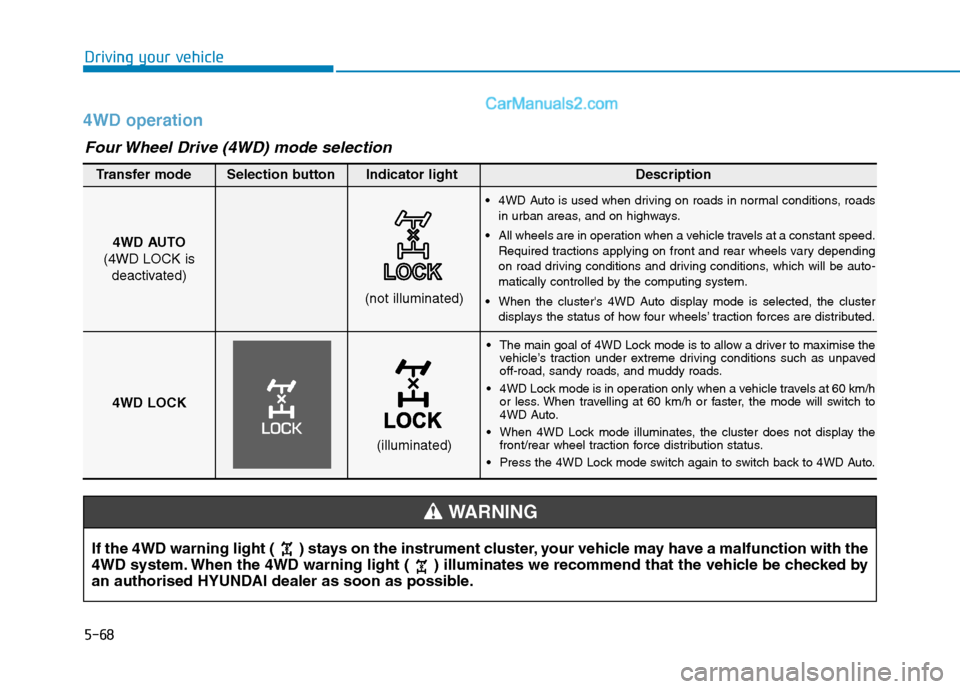
5-68
Driving your vehicle
4WD operation
The main goal of 4WD Lock mode is to allow a driver to maximise the
vehicle’s traction under extreme driving conditions such as unpaved
off-road, sandy roads, and muddy roads.
4WD Lock mode is in operation only when a vehicle travels at 60 km/h
or less. When travelling at 60 km/h or faster, the mode will switch to
4WD Auto.
When 4WD Lock mode illuminates, the cluster does not display the
front/rear wheel traction force distribution status.
Press the 4WD Lock mode switch again to switch back to 4WD Auto.
4WD AUTO
(4WD LOCK is
deactivated)
(not illuminated)
Transfer mode Selection button Indicator light Description
4WD Auto is used when driving on roads in normal conditions, roads
in urban areas, and on highways.
All wheels are in operation when a vehicle travels at a constant speed.
Required tractions applying on front and rear wheels vary depending
on road driving conditions and driving conditions, which will be auto-
matically controlled by the computing system.
When the cluster's 4WD Auto display mode is selected, the cluster
displays the status of how four wheels’ traction forces are distributed.
4WD LOCK
(illuminated)
Four Wheel Drive (4WD) mode selection
If the 4WD warning light ( ) stays on the instrument cluster, your vehicle may have a malfunction with the
4WD system. When the 4WD warning light ( ) illuminates we recommend that the vehicle be checked by
an authorised HYUNDAI dealer as soon as possible.
WARNING
Page 386 of 637

5-69
Driving your vehicle
5
Maintain 4WD Auto mode when
driving on roads in normal con-
ditions.
When driving under normal road
conditions (especially when cor-
nering) in 4WD Lock mode, a
driver may find minor mechani-
cal vibration or noise, which is
extremely normal phenomenon,
not a malfunction. When 4WD
Lock mode is released, such
noise or vibration will be imme-
diately gone.
When the 4WD LOCK mode is
deactivated, a sensation may be
felt as the driving power is deliv-
ered entirely to the front wheels.
For safe 4WD operation
Before driving
Make sure all passengers are
wearing seat belts.
Sit upright and closer to the steer-
ing wheel than usual. Adjust the
steering wheel to a position which
is comfortable for you to drive.
Driving on snow-covered or icy
roads
Start off slowly by applying the
accelerator pedal gently.
Use snow tyres or tyre chains.
Keep sufficient distance between
your vehicle and the vehicle in front
of you.
Use engine braking during deceler-
ation.
Avoid speeding, rapid acceleration,
sudden brake applications, and
sharp turns to prevent skids.
NOTICE
NOTICE
When driving on normal roads,
deactivate the 4WD LOCK mode
by pushing the 4WD LOCK but-
ton (4WD LOCK indicator light
goes off). Driving on normal
roads with the 4WD LOCK
mode, especially, when corner-
ing may cause mechanical
noise or vibration. The noise
and vibration will disappear
when the 4WD LOCK mode is
deactivated. Prolonged driving
with the noise and vibration
may damage some parts of the
power train.
CAUTION
Page 387 of 637
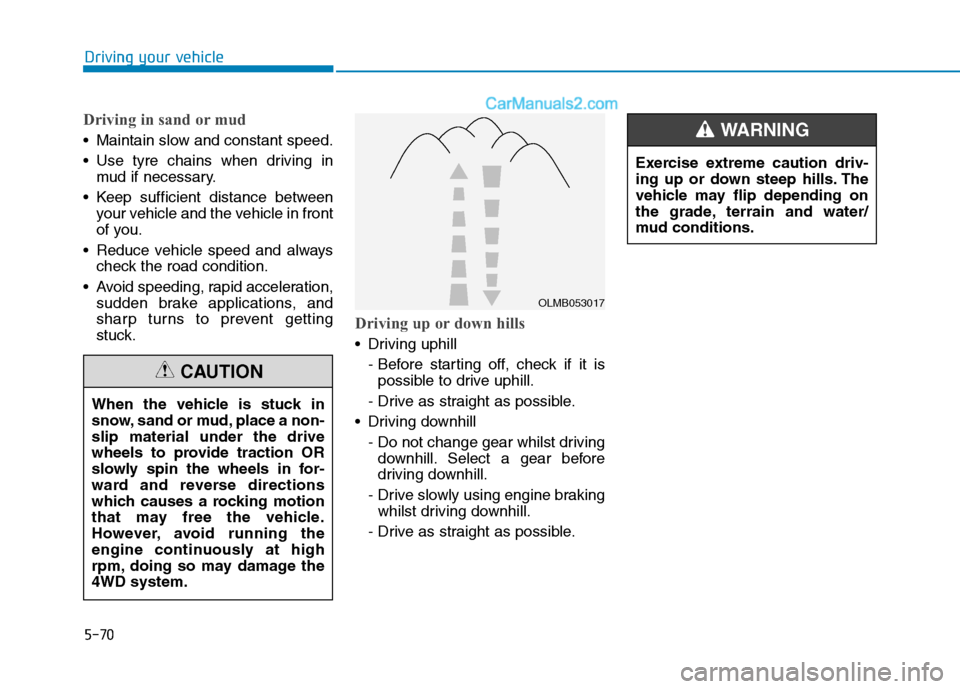
5-70
Driving your vehicle
Driving in sand or mud
Maintain slow and constant speed.
Use tyre chains when driving in
mud if necessary.
Keep sufficient distance between
your vehicle and the vehicle in front
of you.
Reduce vehicle speed and always
check the road condition.
Avoid speeding, rapid acceleration,
sudden brake applications, and
sharp turns to prevent getting
stuck.
Driving up or down hills
Driving uphill
- Before starting off, check if it is
possible to drive uphill.
- Drive as straight as possible.
Driving downhill
- Do not change gear whilst driving
downhill. Select a gear before
driving downhill.
- Drive slowly using engine braking
whilst driving downhill.
- Drive as straight as possible. When the vehicle is stuck in
snow, sand or mud, place a non-
slip material under the drive
wheels to provide traction OR
slowly spin the wheels in for-
ward and reverse directions
which causes a rocking motion
that may free the vehicle.
However, avoid running the
engine continuously at high
rpm, doing so may damage the
4WD system.
CAUTION
OLMB053017
Exercise extreme caution driv-
ing up or down steep hills. The
vehicle may flip depending on
the grade, terrain and water/
mud conditions.
WARNING
Page 388 of 637
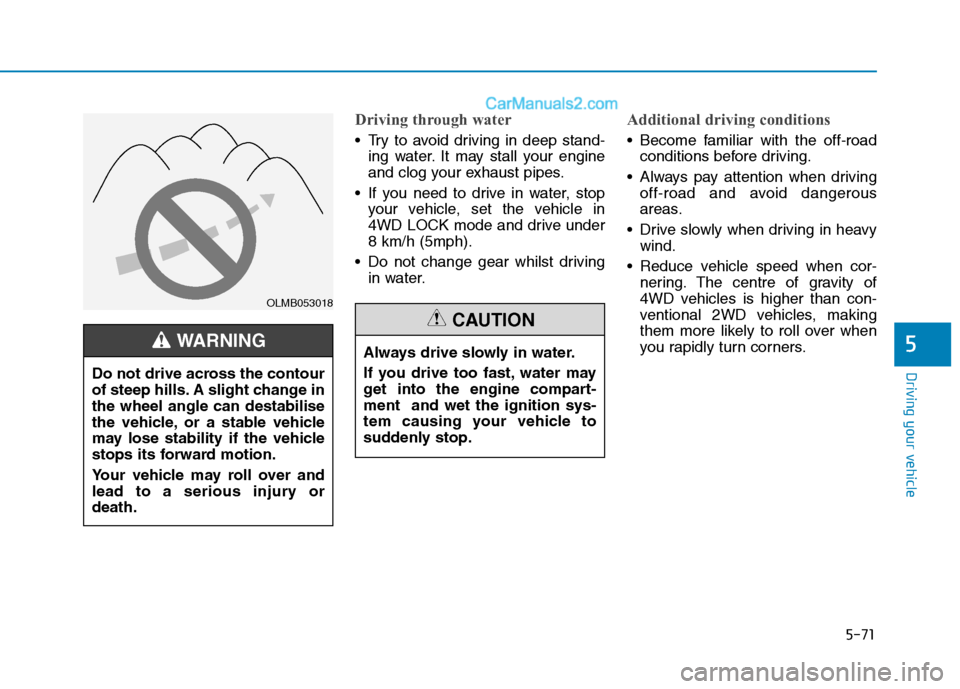
5-71
Driving your vehicle
5
Driving through water
Try to avoid driving in deep stand-
ing water. It may stall your engine
and clog your exhaust pipes.
If you need to drive in water, stop
your vehicle, set the vehicle in
4WD LOCK mode and drive under
8 km/h (5mph).
Do not change gear whilst driving
in water.
Additional driving conditions
Become familiar with the off-road
conditions before driving.
Always pay attention when driving
off-road and avoid dangerous
areas.
Drive slowly when driving in heavy
wind.
Reduce vehicle speed when cor-
nering. The centre of gravity of
4WD vehicles is higher than con-
ventional 2WD vehicles, making
them more likely to roll over when
you rapidly turn corners.
OLMB053018
Do not drive across the contour
of steep hills. A slight change in
the wheel angle can destabilise
the vehicle, or a stable vehicle
may lose stability if the vehicle
stops its forward motion.
Your vehicle may roll over and
lead to a serious injury or
death.
WARNING Always drive slowly in water.
If you drive too fast, water may
get into the engine compart-
ment and wet the ignition sys-
tem causing your vehicle to
suddenly stop.
CAUTION
Page 389 of 637

5-72
Driving your vehicle
Always hold the steering wheel
firmly when you are driving off-
road.
Emergency precautions
Tyres
Do not use tyre and wheel with dif-
ferent size and type from the one
originally installed on your vehicle. It
can affect the safety and perform-
ance of your vehicle, which could
lead to steering failure or rollover
causing serious injury.
When replacing the tyres, be sure to
equip all four tyres with tyres and
wheels of the same size, type, tread,
brand and load-carrying capacity. If
you equip your vehicle with any
tyre/wheel combination not recom-
mended by HYUNDAI for off-road
driving, you should not use these
tyres for highway driving.
Towing
4WD vehicles must be towed with a
wheel lift and dollies or flatbed equip-
ment with all the wheels off the
ground. For more details, refer to
"Towing" in chapter 6.
Dynamometer testing
A full-time 4WD vehicle must be test-
ed on a special four wheel chassis
dynamometer.
OTLE055003
Do not grab the inside of the
steering wheel when you are
driving off-road. You may hurt
your arm by a sudden steering
manoeuvre or from steering
wheel rebound due to an impact
with objects on the ground. You
could lose control of the steer-
ing wheel which may lead to
serious injury or death.
WARNING
Never start or run the engine
whilst a full-time 4WD vehicle is
raised on a jack. The vehicle can
slip or roll off a jack causing
serious injury or death to you or
those nearby.
WARNING
Page 390 of 637
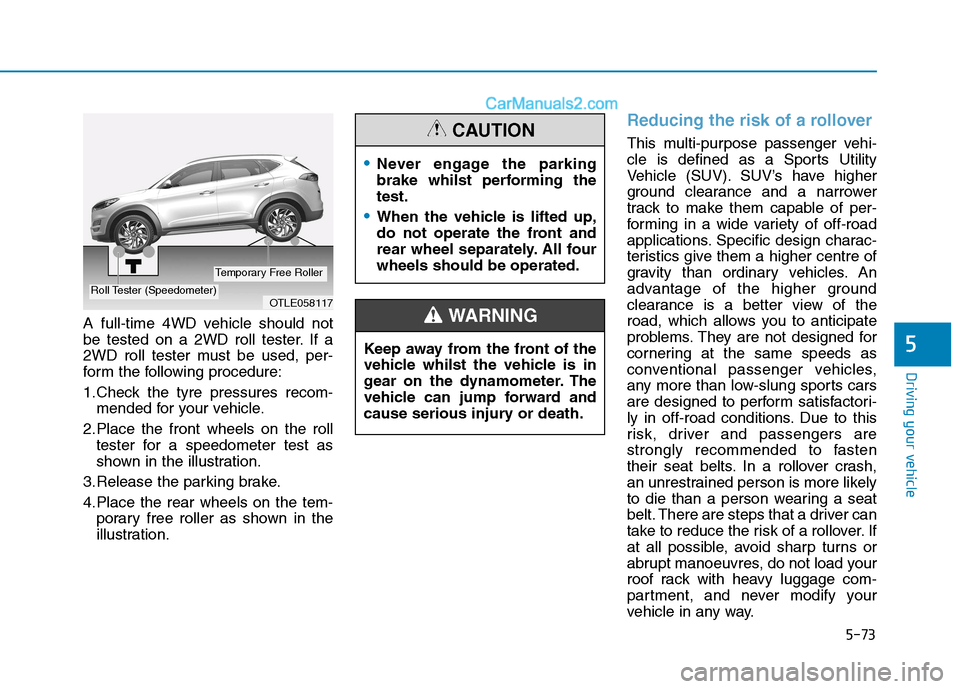
5-73
Driving your vehicle
5
A full-time 4WD vehicle should not
be tested on a 2WD roll tester. If a
2WD roll tester must be used, per-
form the following procedure:
1.Check the tyre pressures recom-
mended for your vehicle.
2.Place the front wheels on the roll
tester for a speedometer test as
shown in the illustration.
3.Release the parking brake.
4.Place the rear wheels on the tem-
porary free roller as shown in the
illustration.
Reducing the risk of a rollover
This multi-purpose passenger vehi-
cle is defined as a Sports Utility
Vehicle (SUV). SUV’s have higher
ground clearance and a narrower
track to make them capable of per-
forming in a wide variety of off-road
applications. Specific design charac-
teristics give them a higher centre of
gravity than ordinary vehicles. An
advantage of the higher ground
clearance is a better view of the
road, which allows you to anticipate
problems. They are not designed for
cornering at the same speeds as
conventional passenger vehicles,
any more than low-slung sports cars
are designed to perform satisfactori-
ly in off-road conditions. Due to this
risk, driver and passengers are
strongly recommended to fasten
their seat belts. In a rollover crash,
an unrestrained person is more likely
to die than a person wearing a seat
belt. There are steps that a driver can
take to reduce the risk of a rollover. If
at all possible, avoid sharp turns or
abrupt manoeuvres, do not load your
roof rack with heavy luggage com-
partment, and never modify your
vehicle in any way.
OTLE058117Roll Tester (Speedometer)
Temporary Free Roller
Never engage the parking
brake whilst performing the
test.
When the vehicle is lifted up,
do not operate the front and
rear wheel separately. All four
wheels should be operated.
CAUTION
Keep away from the front of the
vehicle whilst the vehicle is in
gear on the dynamometer. The
vehicle can jump forward and
cause serious injury or death.
WARNING